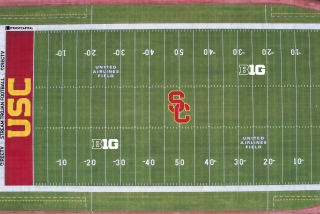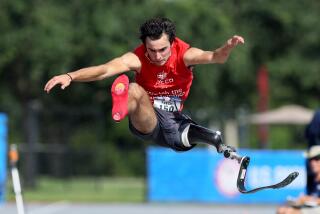TRACK AND FIELD : Coliseum Has Provided Great Moments
- Share via
Parry O’Brien was reminiscing recently about the Coliseum, which was once the citadel for track and field in the United States.
“I remember training there at night by the light of the Olympic torch at the peristyle entrance in the Olympic year of 1952,” O’Brien said. “It provided a great deal of inspiration.”
O’Brien, the former USC star, was a gold medalist in the shotput in 1952 and again in 1956. It was at the Coliseum on May 8, 1954, where he became the first man to break the 60 foot barrier in the event with an effort of 60 feet 5 1/4 inches.
O’Brien’s record came only two days after Roger Bannister became the first man to run a sub-four minute mile.
The Coliseum has been the site of two Olympic Games, 1932 and 1984, numerous international meets, NCAA competition, the Coliseum Relays and exciting dual meets between USC and UCLA. However, it may become obsolete for track competition in the future with planned renovations to lower seating to field level and cover the track.
Only in the event of another Olympic Games, or World Championships, would the track be restored.
With considerable help from track historians Dwain Esper and Harley Tinkham, let’s take a random look at some of the special moments in the sport at the Coliseum, realizing that there probably will be some notable omissions.
1935--This was the year that the late Jesse Owens set three world records and tied another (100, 220 and 220-yard low hurdles and long jump) in one day, May 25, in the Big Ten meet at Ann Arbor, Mich.
In a footnote to what is often considered the most outstanding accomplishment in track and field, Owens came to the Coliseum later, representing Ohio State for a special dual meet with USC.
Owens then set some Coliseum records while winning the same four events against one of USC’s strongest teams.
1937--They were called the “Heavenly Twins,” USC pole vaulters Bill Sefton and Earle Meadows.
In a Pacific Coast Conference meet at the Coliseum, Sefton was the first to clear the world record height of 14 feet, 11 inches. Meadows equalled the record.
They couldn’t go any higher because the pole vault standards were stretched to the limit.
1941--On June 17 in a PCC-Big Ten meet, Oregon’s Les Steers, with a unique belly roll technique, squirmed over the high jump bar at 6 feet, 11 inches for a world record.
Another world record was set when California and USC each entered mile relay teams opposing the Big Ten.
The Big Ten was quickly out-distanced as the quarter-milers from Cal and USC matched each other stride for stride.
Cal’s Grover Klemmer ran the anchor leg opposing USC’s Hubie Kerns. They reached the finish line in a virtual dead heat with Cal being declared the winner in the world record time of 3:09.4. USC had the same time.
1947--In a dual meet between USC and Illinois, the 220-yard dash featuring USC’s Mel Patton and Illinois’ Herb McKenley was the featured race. McKenley was the world record holder in the 440.
In those days the 220, or 200 meters, wasn’t run around a curve for most meets, but on a straightaway, starting deep in the Coliseum tunnel.
The starting gun had an echoing effect in the tunnel. Patton soon emerged, but McKenley wasn’t in sight. When he came into view, he was thoroughly beaten as Patton went on to win in 20.4 seconds.
Patton would, of course, go on to set world records at 100 and 220 yards.
1956--The eight foot barrier in the high jump has since been cleared, and, during the Olympic Trials at the Coliseum, Charles Dumas became the first man to clear seven feet with a startling jump at that time of 7-0 1/2.
There are, of course, other memorable Coliseum moments such as:
--Paavo Nurmi, the famous Flying Finn, performing before a crowd estimated at 80,000 in the 1920s and then coming back on request to run again the next night.
--Gerry Lindgren, a high school student in Spokane, Wash., beating a more experienced Soviet runner in the 10,000 meters in the U.S.-USSR meet in 1966. Russ Hodge set a world decathlon record of 8,230 points in that meet.
--In the U.S.-USSR meet two years earlier, Dallas Long broke the world record in the shot put by nearly two feet with a throw of 67-10 1/4.
--Jim Ryun set a world record in the 1,500 meters of 3:33.1 in the International Games in 1967. It would last for seven years.
--In a 1956 dual meet between USC and UCLA, an invitational mile was held featuring Jim Beatty and Australia’s John Landy. Beatty won in the time of 3:58.6, the first sub-four minute mile ever run in the U.S.
--USC’s Rex Cawley set a world record of 49.1 in the 400-meter hurdles in the Olympic Trials in 1964 and Rick Wohlhuter set a world record of 1:44.6 in the 880 in 1973.
Then there are the lighter moments, such as a meet in the 1950s when O’Brien was competing in the shotput.
O’Brien got off a long throw, prompting a self-styled expert in the stands to exclaim, “That’s one of the longest shotputs I’ve ever seen.”
Sitting behind the man, Tinkham tapped him on the shoulder, and said, “Were you in Eskilstuna, Sweden, on Aug. 20, 1950, when Jim Fuchs set the world record at 58-10 3/4?”
The man replied, “Of course not.” With that detail out of the way, Tinkham said knowingly: “That is the longest shotput you have ever seen.”
In an effort to restore American prestige in the decathlon, former gold medal winners under the sponsorship of Visa gathered at San Francisco State earlier this month to impart their knowledge to today’s decathletes.
It was an imposing list: Bob Mathias, gold medal winner in 1948 and 1952: Milt Campbell in 1956, Rafer Johnson in 1960, Bill Toomey in 1968 and Bruce Jenner in 1976.
“The process was to go through each event, such as starting blocks and a timer, to record reflex time, speed acceleration for the first 50 yards, a density tank, a treadmill, and ultra high speed cameras for field events,” Mathias said.
Dave Johnson, the world’s second-ranked decathlete, said the program was especially helpful for him--just associating with former gold medal winners.
“I learned a lot from them,” Johnson said. “We’ve never had a camp like this to get a good psychological advantage through the former gold medalists.”
Johnson, 27, who formerly competed for Azusa Pacific, is the American record-holder in the decathlon--with an asterisk.
He has 8,549 points under the tables adjusted for the new javelin that doesn’t go as far. He would most likely break Jenner’s U.S. record of 8,634 points had he been allowed to throw the old javelin. It’s one of his best events.
Johnson, who placed ninth in the 1988 Seoul Olympics, is hopeful of improving considerably by the 1992 Games.
“I have to improve on the first day events: 100, long jump, shotput, high jump and 400. I don’t think anyone can take me the second day,” Johnson said.
He says that he doesn’t particularly care for the shotput.
“It’s just a big old ball and you get to look at it for maybe two seconds then there’s big hole in the ground,” Johnson said.
More to Read
Go beyond the scoreboard
Get the latest on L.A.'s teams in the daily Sports Report newsletter.
You may occasionally receive promotional content from the Los Angeles Times.










